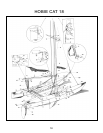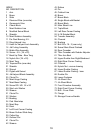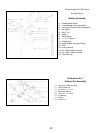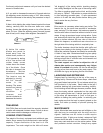
A good anti-fouling paint can be applied for some
protection from marine growth before mooring. Before
painting, it is suggested that the area be masked off to
ensure a clean line. No friction reducing paints or agents
may be employed on a Hobie Cat during competition.
HOBIE CLASS ASSOCIATION
The Hobie Class Association was started by a group of Hobie
owners who got together back in 1968 to organize some
racing and other activities. Hobie was the mainstay of the
group promoting the activities himself. At that time, it wasn't
really a class association but simply a group of owners
wanting to have fun with their new toys. Hobie would write
brief newsletters from the factory announcing regattas as they
developed across the country. He published a set of class
rules rigidly restricting changes and modifications which can
be made to the boat. As the class started to grow, people were
hired to help administer the program. At that point, the
association became a little more formal: the groundwork for
the establishment of fleets was developed and the Hobie Cat
Hotline was initiated as a class newsletter.
The Class Association was originally organized around one
basic consideration: to extend each Hobie owner's enjoyment
through organized, family oriented activities. Innovations were
made in racing procedures and the regatta structures. A
policy of including the whole family in the activities developed
to assure everyone would have fun at Hobie regatta. The
Association continually strives to develop better programs so
owners may further enjoy their Hobies
KNOW YOUR KNOTS
FIGURE 8 KNOT
BOWLINE KNOT
HALYARD KNOT
CLEATING OFF A LINE
30
lamps. The wire coupling to the towing vehicle should
be high enough to stay dry. Never rely on the trailer
hitch for ground connection. Four-pole connectors
should be used.
The mast should not extend over three feet behind the
rear light assembly.
Wheels: Tires should ALWAYS be inflated to
manufacturer's recommended pressure. Always carry a
spare wheel and a jack that fit the boat trailer. If wheel
bearings are always dunked, waterproof bearings and
caps should be considered. If water is allowed into the
hub, lubricating grease will float away and bearings will
burn out or seize, causing damage and a safety hazard.
Waterproofed bearings should be inspected prior to
each boating season, others more often. Special care
should be given when traveling on unimproved
roadways with small diameter wheels.
If a spare wheel is not available, a spare wheel bearing
set should be taken on long trips in case the grease seal
has been broken.
FRAME AND ROLLERS
Rust should not be allowed to accumulate. Remove rust
and repaint with anti-rust paint. Some trailers offer
galvanized coating to prevent rust. Rollers should roll
freely and should not have checks, breaks or flat spots.
TOWING VEHICLE
Most vehicles are limited in towing capacity. Towing
heavy loads places extra demands on the engine,
transmission, brakes and other systems vital to the
vehicle. Towing "packages" are available through most
auto dealers and should be considered for heavy boats.
MOORING:
Mooring a Hobie is not recommended as it will cause
deterioration and discoloration of the hull. If, however, it
has to be moored for a short time the main thing to
remember is make sure everything is snug and secure.
Obviously the first thing to do is tie the boat securely to
the mooring. Then furl the sail and secure all gear so it
can't chafe when swells and boat wakes rock and thrash
to boat. Last, but very important, be sure all shrouds are
tight so the mast can't flop and fatigue the wires in the
shrouds. Many an unsuspecting boat owner has moored
his boat for a few days only to return to find his mast
laying in the water. The easiest way to tighten the
shrouds is to run a line around a shroud, under the
boom and around the other shroud. Tightening this line
will tighten the shrouds and minimize fatigue and wear.
Another method is to install a shroud tension adjuster (a
single line tied to the bridle intersection and run through
a cleat near the mast on the front cross bar). Tightening
the shroud adjuster will tighten the shrouds.
FIGURE 8 KNOT
AT END OF LINE


















